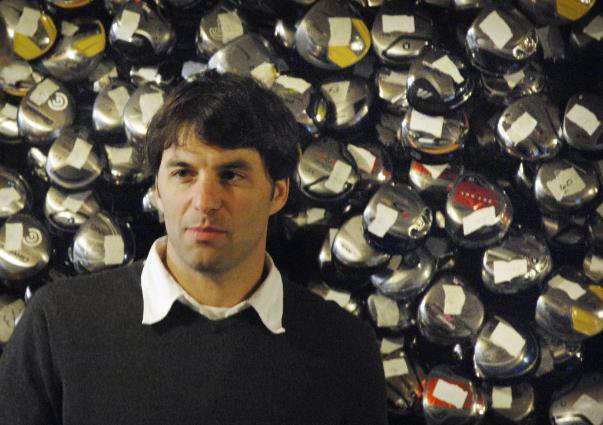With second chance, 2nd Swing finds the green
By
ERIC WIEFFERING,
Star Tribune
Star
Tribune Updated: April 7, 2012 - 9:33 PM

Simon Kallal, co-owner of
2nd Swing Golf with some of the store's inventory in the basement of the
Hennepin Avenue store in Minneapolis. Photo: Glen Stubbe, Star
Tribune
Simon Kallal's first golf venture, 2nd Swing,
found water in 2006, when it was liquidated in bankruptcy.
Fired from 2nd Swing a year before it went under, Kallal had every good
reason to move on.
Instead, he teed up 2nd Swing again, this time with much different
results.
That's evident at the Minneapolis store on a warm Friday afternoon in
early April. Golfers swarm the racks of used clubs on the main floor and
in the basement. Some are just window shopping, but many seem intent on
trading in the clubs they already own toward the purchase of another
set.
They line up to test the equipment in the store's four new hitting bays,
built at a cost of $100,000. After hitting balls into a net, they turn
to the giant flat-screen monitor, where sophisticated equipment spits
out ball speed, launch angle, spin rate and other data.
The 2nd Swing of today is a more evolved version of the idea Kallal had
way back in 1996 when, as an undergraduate accounting major playing on
the University of Minnesota golf team, he dreamed up the idea for a
store that bought and sold used golf clubs.
This was pre-eBay, and golf appeared poised to benefit from a huge
demographic and technological changes. Tiger Woods had just turned pro,
introducing the sport to a younger and more racially diverse audience.
Equipment companies, meanwhile, were pushing out a new generation of
clubs that allowed players of all abilities to hit the ball farther and
straighter.
The first 2nd Swing store opened in 1997 on East Hennepin Avenue in
Minneapolis. By the end of the decade, there were four.
Then things got crazy. Outside investors bought into the chain and
bankrolled a big expansion. Within three years, 2nd Swing had 35 stores
and was trying to raise up to $20 million in an initial stock offering.
That's when reality intruded.
Golf's boom had turned to bust. The number of played rounds plunged in
the wake of the dot-com collapse, the 9/11 attacks and a recession. 2nd
Swing pulled its stock sale and raised an additional $17 million from
private investors.
By then, Kallal worried that the company had strayed from its original
mission. The stores were getting bigger, but no more profitable, and
they relied increasingly on sales of new equipment, which meant 2nd
Swing was competing more directly with big-box retailers.
Kallal, who was president, said he his concerns went unheeded. By then,
his stake in the company had been reduced to less than 10 percent. He
was fired in 2005.
"They had to fire me, in a way, because I had such a different vision
for the business," he said.
When 2nd Swing went bankrupt a year later, Kallal, who was already
planning another used golf club store, bought the name for $50,000. He
reopened 2nd Swing in 2007, determined to avoid mistakes made the first
time around.
Used clubs are the heart of that strategy. In addition to taking trades
from retail customers, the company developed trade-in arrangements with
high-end private courses and PGA professionals that helped boost
inventory to 19,000 clubs.
Kallal's team also invested heavily in pricing and inventory tracking
software. As soon as a club enters the database, it appears on 2nd
Swing's own website, where 50 percent of sales occur, as well as on
sites of other online retailers such as Amazon and eBay.
Orders come from around the world. "At this time of the year we're
shipping about 1,000 clubs a week," Kallal said.
With online sales growing at a brisk 40 percent rate, 2nd Swing can
afford to be conservative about investing in new brick-and-mortar
storefronts. Current plans call for only five stores in 10 years.
Kallal also has repaired relationships with equipment manufacturers,
many of which were burned when 2nd Swing went under in 2006. New club
sales will probably never amount to more than 20 percent of revenue, but
Kallal knows it's critical to be able to offer them to customers who
want to trade old sticks for new ones.
Meanwhile, the 2nd Swing sequel is playing better than the original.
The first 2nd Swing never turned a profit. Version 2.0 turned its first
profit in 2009 -- a generally terrible year for most retailers.
The first 2nd Swing piled up $10 million in debt. This time, Kallal has
relied on $130,000, a seven-year bank loan and cash flow.
Outside investors? Forget about it. Kallal and his family own about 75
percent of the stock, with the rest spread among key employees.
The gradually improving economy is trickling down to the golf sector.
Total rounds played are up this year. And Kallal, who spends 30 hours or
more on the sales floor during the peak summer months, can tell that
consumers are feeling more confident about the economy. Instead of
buying a newer driver or hybrid, they're springing for a more costly set
of irons.
When he bought the 2nd Swing name out of bankruptcy, Kallal was
initially inclined not to use it at all, fearing the brand had been
permanently damaged. His colleagues convinced him to poll customers, and
the response was overwhelming.
"People liked the concept a lot," Kallal said.
And this time, no shanks. He's striking it pure.
ericw@startribune.com • 612-673-1736 |

